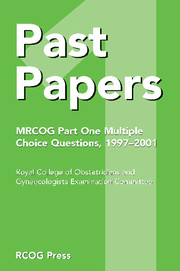Book contents
- Frontmatter
- Contents
- Introduction
- March 1997 – Paper 1
- March 1997 – Paper 2
- September 1997 – Paper 1
- September 1997 – Paper 2
- March 1998 – Paper 1
- March 1998 – Paper 2
- September 1998 – Paper 1
- September 1998 – Paper 2
- March 1999 – Paper 1
- March 1999 – Paper 2
- September 1999 – Paper 1
- September 1999 – Paper 2
- March 2000 – Paper 1
- March 2000 – Paper 2
- September 2000 – Paper 1
- September 2000 – Paper 2
- March 2001 – Paper 1
- March 2001 – Paper 2
- September 2001 – Paper 1
- September 2001 – Paper 2
- Index
September 1998 – Paper 1
Published online by Cambridge University Press: 05 July 2014
- Frontmatter
- Contents
- Introduction
- March 1997 – Paper 1
- March 1997 – Paper 2
- September 1997 – Paper 1
- September 1997 – Paper 2
- March 1998 – Paper 1
- March 1998 – Paper 2
- September 1998 – Paper 1
- September 1998 – Paper 2
- March 1999 – Paper 1
- March 1999 – Paper 2
- September 1999 – Paper 1
- September 1999 – Paper 2
- March 2000 – Paper 1
- March 2000 – Paper 2
- September 2000 – Paper 1
- September 2000 – Paper 2
- March 2001 – Paper 1
- March 2001 – Paper 2
- September 2001 – Paper 1
- September 2001 – Paper 2
- Index
Summary
1. The pineal gland
A. is situated at the anterior end of the third ventricle.
B. is innervated by the parasympathetic nervous system.
C. produces melatonin.
D. may be calcified in the adult.
E. is most active during daylight.
2. The anal canal
A. has an upper part which is innervated by the inferior hypogastric plexus.
B. has a lower part which is supplied by the superior rectal artery.
C. drains lymph to the superficial inguinal nodes from its upper part.
D. has its internal sphincter innervated by the inferior rectal nerve.
E. has a superficial part of its external sphincter attached to the coccyx.
3. The pudendal nerve
A. arises from the posterior rami of S2, 3 and 4.
B. leaves the pelvis through the lesser sciatic foramen.
C. crosses the ischial spine on the lateral side of the internal pudendal artery.
D. supplies the levator ani.
E. supplies the clitoris.
4. The pelvic splanchnic nerves
A. are derived from the posterior rami of the sacral spinal nerves.
B. supply afferent fibres.
C. unite with branches of the sympathetic pelvic plexus.
D. supply the ascending colon with motor fibres.
E. supply the uterus with parasympathetic fibres.
5. In the vulva
A. blood is supplied by the internal pudendal artery.
B. the anterior parts of the labia majora are innervated by the obturator nerves.
C. the posterior parts of the labia majora are innervated by the genitofemoral nerves.
D. the lesser vestibular glands lie deep to the bulb of the vestibule.
E. the round ligaments of the uterus terminate in the labia minora.
- Type
- Chapter
- Information
- Past Papers MRCOG Part One Multiple Choice Questions1997–2001, pp. 61 - 70Publisher: Cambridge University PressPrint publication year: 2004



